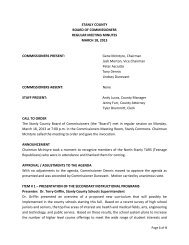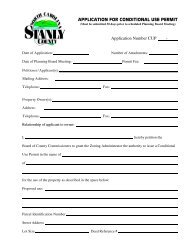Land Use Plan – 2002 - Stanly County, North Carolina
Land Use Plan – 2002 - Stanly County, North Carolina
Land Use Plan – 2002 - Stanly County, North Carolina
Create successful ePaper yourself
Turn your PDF publications into a flip-book with our unique Google optimized e-Paper software.
STANLY COUNTY<br />
needs of the airport, this area is also an ideal location for industrial development within the<br />
study area.<br />
Presently an overlay zoning district protects the airport from tall structures. It is<br />
recommended that the existing overlay zoning district be expanded to provide further<br />
protection to the airport by encouraging compatible land uses (such as industrial<br />
development) while discouraging others.<br />
Morrow Mountain State Park Protection Area—Morrow Mountain State Park remains one<br />
of the most important assets in <strong>Stanly</strong> <strong>County</strong> since its creation in 1935. The Morrow<br />
Mountain State Park Protection Area is recommended to protect and enhance this valuable<br />
resource from incompatible development at the park boundary. Views and vistas to and<br />
from the park should be protected, as should the Valley Drive State Scenic Byway that<br />
passes on the west side of the state park. Ridgelines in the area should be protected. The<br />
existing H-0, Highway Overlay District that protects important roadway corridors in the<br />
county could be used as the model for protecting this valuable resources.<br />
Rocky River Greenway Protection Area—The Rocky River presents a unique opportunity<br />
to link southern <strong>Stanly</strong> <strong>County</strong> with a regional greenway to Cabarrus, Mecklenburg, and<br />
Union Counties and the Charlotte metropolitan area. A multi-purpose greenway is<br />
recommended for this corridor, a greenway that ultimate would link to the Yadkin-Pee Dee<br />
River at Norwood.<br />
The greenway proposed for the Rocky River Protection Area—as discussed in <strong>Land</strong> <strong>Use</strong><br />
<strong>Plan</strong> principle #7 above—can serve a multitude of functions and take on a multitude of roles<br />
for the county. Those functions and roles can define the manner in which the greenway<br />
develops, be it as an natural conservation area to protect the Rocky River and its sensitive<br />
habitats, or to serve as a linear park with trails and infrastructure supporting walking, biking,<br />
canoeing, and other activities.<br />
Regardless, the concept of developing a greenway along the Rocky River was presented by<br />
county residents throughout the Public Input Meeting process as a way of preserving this<br />
important corridor. The greenway concept is a natural outgrowth of the work of Frederic Law<br />
Olmsted and his “emerald necklace” regional linear park systems in Boston, Massachusetts,<br />
and Cleveland, Ohio a century ago. Greenways systems have blossomed throughout the<br />
county in the last quarter century. Many of the more successful systems can be found in<br />
<strong>North</strong> <strong>Carolina</strong>, such as in Raleigh.<br />
The greenway could also serve as a means to link existing or future recreational areas in<br />
southern <strong>Stanly</strong> <strong>County</strong>. The greenway will pass in close proximity to cities such as<br />
Norwood, Oakboro, Stanfield, and Locust, as well as the town of Aquadale. The greenway<br />
could provide a backbone to link all these communities. On a grander scale, the greenway<br />
could tie into regional parks and recreation facilities in the Charlotte region.<br />
Growth Management and Implementation Strategies and Tools<br />
The <strong>Land</strong> <strong>Use</strong> <strong>Plan</strong> and its supporting principles refer to several growth management and<br />
implementation strategies and tools that are available to <strong>Stanly</strong> <strong>County</strong> as a resource for<br />
realizing the plan goals and objectives. These strategies include the following:<br />
Agricultural districts,<br />
Conservation development,<br />
Conservation easements,<br />
Transfer of development rights,<br />
Purchase of development rights,<br />
Traditional neighborhood design,<br />
Cost of community services,<br />
<strong>Land</strong> <strong>Use</strong> <strong>Plan</strong> 6-15 6/02






